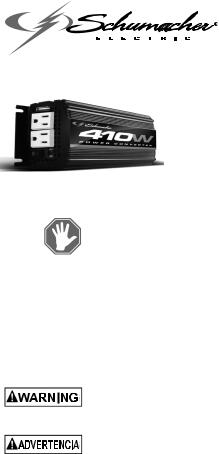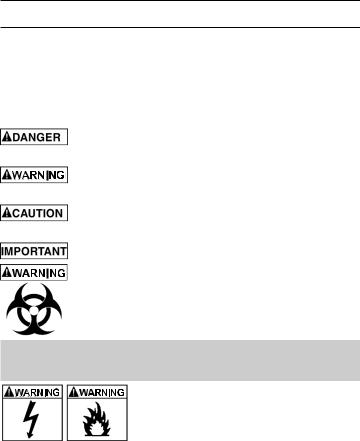Schumacher X141B User Manual

OWNER’S MANUAL
MANUAL DEL USUARIO
Model/Modelo: XI41B
Power Converter
Converts 12V DC Battery Power to 120V AC Household Power
Convertidor de Energía
Convierte la Energía de Baterías de 12V de CC a 120V de CA de Energía Doméstica
DO NOT RETURN THIS PRODUCT TO THE STORE!
Contact Customer Service for assistance: Phone: 800-621-5485
Email: services@schumacherelectric.com Web: www.batterychargers.com
¡NO LO DEVUELVA ESTE PRODUCTO A LA TIENDA!
Contacte Servicios al Cliente para asistencia: Teléfono: 800-621-5485
Correo Electrónico: services@schumacherelectric.com Sitio Red: www.batterychargers.com
READ THE ENTIRE MANUAL BEFORE USING THIS PRODUCT. FAILURE TO DO SO COULD RESULT IN SERIOUS INJURY OR DEATH.
LEA EL MANUAL COMPLETO ANTES DE UTILIZAR ESTE PRODUCTO. CUALQUIER FALLA PODRÍA RESULTAR EN SERIAS LESIONES O PODRÍA
SER MORTAL.
0099001307-00

IMPORTANT: READ AND SAVE THIS SAFETY AND INSTRUCTION MANUAL.
SAVE THESE INSTRUCTIONS – This manual will show you how to use your converter safely and effectively. Please read, understand and follow these instructions and precautions carefully, as this manual contains important safety and operating instructions. The safety messages used throughout this manual contain a signal word, a message and an icon.
The signal word indicates the level of the hazard in a situation.
Indicates an imminently hazardous situation which, if not avoided, will result in death or serious injury to the operator or bystanders.
Indicates a potentially hazardous situation which, if not avoided, could result in death or serious injury to the operator or bystanders.
Indicates a potentially hazardous situation which, if not avoided, could result in moderate or minor injury to the operator or bystanders.
Indicates a potentially hazardous situation which, if not avoided, could result in damage to the equipment or vehicle or property damage.
Pursuant to California Proposition 65, this product contains chemicals known to the State of California to cause cancer and birth defects or other reproductive harm. Wash hands after handling.
1.IMPORTANT SAFETY INSTRUCTIONS – SAVE THESE INSTRUCTIONS.
This manual contains important safety and operating instructions.
RISK OF ELECTRIC SHOCK OR FIRE.
1.1Keep out of reach of children.
1.2Keep the converter well ventilated in order to properly disperse heat generated while it is in use. Make sure there are several inches of clearance around the top and sides and do not block the slots of the converter.
• 2 •

1.3Make sure the converter is not close to any potential source of flammable fumes or clothing.
1.4Do not place the converter in areas such as battery compartments or engine compartments where fumes may accumulate.
1.5Keep the converter dry.
1.6DO NOT allow the converter to come into contact with rain or moisture.
1.7DO NOT operate the converter if you, the converter, the device being operated or any other surfaces that may come into contact with any power source are wet. Water and many other liquids can conduct electricity, which may lead to serious injury or death.
1.8Do not place the converter on or near heating vents, radiators or other sources of heat or flammable materials.
1.9Do not place the converter in direct sunlight. The ideal air temperature for operation is between 50° and 80°F.
1.10Only connect the power converter to a 12V accessory outlet. Do not attempt to connect the converter to any other power source, including an AC power source. Connecting to a 6V or 16V battery will cause damage to the converter.
1.11Make sure the AC plug connection is tight.
1.12Do not modify the converter in any way including cables, plugs or switches as it may result in property damage or personal injury.
1.13  Incorrect operation of your converter may result in damage and personal injury. The converter output is 120V AC and can shock or electrocute the same as any ordinary household AC wall outlet.
Incorrect operation of your converter may result in damage and personal injury. The converter output is 120V AC and can shock or electrocute the same as any ordinary household AC wall outlet.
1.14Do not open – no user serviceable parts inside.
1.15This device does not include an internal Ground Fault Circuit Interrupter (GFCI).
2.BEFORE USING YOUR POWER CONVERTER
NOTE: This converter is designed to be used with a single battery, up to group 31 (130 Ah or smaller). The recommended source of power is a 12 volt deep-cycle battery, due to their high reserve capacity. Automotive batteries are recommended for only a short period of time of an hour or less.
•3 •
NOTE: Do not use the converter with a product that draws a higher wattage than the converter can provide, as this may cause damage to the converter and product.
When you turn on a device or a tool that runs on a motor, the device basically goes through two stages:
1.Start Up – Requiring an initial surge of power (commonly known as the “starting load” or “peak load”).
2.Continuous Operation – Power consumption drops (commonly known as the “continuous load”).
The wattage (WATTS) or amperes (AMPS) can normally be found stamped or printed on most devices and equipment, or in the user’s manual. Otherwise, contact the manufacturer to find out whether the device you want to use is compatible with a modified sine wave.
To calculate the wattage: Wattage = AMPS x 120 (AC Voltage).
To calculate the starting load: Starting Load = 2 x WATTS. In general, the start up load of the device or power tool determines whether your converter has the capability to power it.
To calculate the continuous load: Continuous Load = AMPS x 120 (AC Voltage).
 Always run a test to establish whether the converter will operate a particular piece of equipment or device. In the event of a power overload, the converter is designed to automatically shut down. This safety feature prevents damaging the converter while testing devices and equipment within the wattage range of the converter.
Always run a test to establish whether the converter will operate a particular piece of equipment or device. In the event of a power overload, the converter is designed to automatically shut down. This safety feature prevents damaging the converter while testing devices and equipment within the wattage range of the converter.
 When using the vehicle’s 12 volt accessory port, this converter is designed to supply 60 to 70 watts when the vehicle is not running. With the vehicle’s engine running, it can supply up to 100 watts. To use the full output, you must connect the converter directly to your battery.
When using the vehicle’s 12 volt accessory port, this converter is designed to supply 60 to 70 watts when the vehicle is not running. With the vehicle’s engine running, it can supply up to 100 watts. To use the full output, you must connect the converter directly to your battery.
NOTE: The 100 watt limit is to accommodate the fuse ratings for all vehicles. Some vehicles may allow the full output. If the fuse blows when you switch on the device you are trying to use, you have to either use a smaller device or you must connect the converter directly to the battery.
• 4 •

 This converter uses a nonsinusoidal waveform. Therefore, we do not recommend you use it to power the following devices:
This converter uses a nonsinusoidal waveform. Therefore, we do not recommend you use it to power the following devices:
1.Switch mode power supplies
2.Linear power supplies
3.Class 2 transformers
4.Line filter capacitors
5.Shaded pole motors
6.Fan motors
7.Microwave ovens
8.Fluorescent and high intensity lamps (with a ballast)
9.Transformerless battery chargers
Doing so may cause the device to run warmer or overheat.
3.FASTENING THE CONVERTER TO A FLAT SURFACE
For convenience, your converter can be fastened to a flat surface, horizontally or vertically. The area where the converter is to be fastened must be dry, well ventilated and away from any combustible material or fumes.
1.Turn off and disconnect the converter.
2.Place the back of the converter with the mounting bracket against a secure and flat surface.
3.Attach the converter to the flat surface using corrosionresistant screws.
4.CONNECTING CONVERTER CABLES
The converter and power source must be in the OFF mode.
 Make sure you connect your converter to a 12V power supply only.
Make sure you connect your converter to a 12V power supply only.
Converter connection:
1.Locate the positive and negative plastic terminals located on the back of the converter and remove the terminal caps completely.
2.Install the positive (red) cable ring lug onto the positive (red) terminal screw. Install the negative (black) cable ring lug onto the negative (black) terminal screw. Tighten each terminal, so that the cable cannot come loose.
•5 •

Connecting converter cable to a vehicle (100 watts maximum):
1.Remove the cigarette lighter from its outlet.
2.Push the 12V power plug firmly into the outlet.
Connecting converter cables to 12V battery or 12V power source:
1.Keep hands, hair, clothing and jewelry clear of battery terminals.
2.Wear eye protection and protective clothing.
3.Connect the positive (red) converter terminal cable to the power source positive (+) or battery terminal. Make sure the connection is secure.
4.Connect the negative (black) converter terminal cable to the power source negative (-) or battery terminal. Make sure the connection is secure.
5.To disconnect the converter, reverse the above steps.
NOTE: The internal speaker may make a brief “beep” when the converter is being connected to or disconnected from the 12V power source.
 Failure to make the correct connections will result in blown fuses and permanent damage to the converter.
Failure to make the correct connections will result in blown fuses and permanent damage to the converter.
5.OPERATING INSTRUCTIONS
1.Connect the converter (see “CONNECTING CONVERTER CABLES” section).
2.Make sure the device to be operated is turned OFF.
3.Plug the device into the converter’s AC outlet.
4.Switch the converter’s ON/OFF switch to the ON position.
5.Turn the device on.
6.To disconnect, reverse the above procedure.
NOTE: If more than one device is to be powered, start one device at a time to avoid a power surge and overloading the converter. The surge load of each device should not exceed the converter’s Continuous Operation wattage rate.
 If you are using the power converter to operate a battery charger, monitor the temperature of the battery charger for about 10 minutes. If the battery charger becomes abnormally warm, disconnect it from the converter immediately.
If you are using the power converter to operate a battery charger, monitor the temperature of the battery charger for about 10 minutes. If the battery charger becomes abnormally warm, disconnect it from the converter immediately.
• 6 •

NOTE: You can use an extension cord from the converter to the device without significantly decreasing the power being generated by the converter. For best operating results, the extension cord should be no longer than 50 feet.
Using the converter to operate a TV or audio device:
The converter is shielded and filtered to minimize signal interference. Despite this, some interference may occur with your television picture, especially with weak signals. Below are some suggestions to try and improve reception.
1.Make sure the television antenna produces a clear signal under normal operating conditions (i.e. at home plugged into a standard 120V AC wall outlet). Also, ensure that the antenna cable is adequately shielded and of good quality.
2.Try altering the position of the converter, antenna cables, and television power cord. Add an extension cord from the converter to the TV, to isolate its power cord and antenna cables from the 12V power source.
3.Try coiling the television power cord and the input cables running from the 12V power source to the converter.
4.Affix one or several “Ferrite Data Line Filters” to the television power cord. Ferrite Data Line Filters can be purchased at most electronic supply stores.
NOTE: You may hear a “buzzing” sound being emitted from inexpensive sound systems when operated with the converter.
This is due to ineffective filters in the sound system’s power supply.
Unfortunately, this problem can only be resolved by purchasing a sound system with a higher quality power supply or higher quality filter.
Using the USB Port:
The USB Port provides up to 2.1A at 5V DC.
1.Plug the device into the USB port.
2.Turn the USB device on.
3.Reverse these steps when finished using the USB port.
The converter draws power, even when the 


 switch is OFF. To avoid battery drain, disconnect the converter when not in use.
switch is OFF. To avoid battery drain, disconnect the converter when not in use.
• 7 •

6.POWER SOURCE
To get the best performance out of your converter, we recommend that you use it with the vehicle’s engine running.
Your average automobile or marine battery at full charge will provide an ample power supply to the converter for approximately 3 hours when the engine is off. The actual length of time the converter will function depends on the age and condition of the battery and the power demand being placed by the device being operated with the converter.
If you decide to use the converter while the engine is off, we recommend you turn OFF the device plugged into the converter before starting the engine. To maintain battery power, start the engine every 2 to 3 hours and let it run for approximately 10 minutes to recharge the battery.
Although it is not necessary to disconnect the converter when turning over the engine, it may briefly cease to operate as the battery voltage decreases. While the converter draws very low amperage when not in use, it should be unplugged to avoid battery drain.
7.LED INDICATOR AND SHUTDOWN PROTECTION
The LED glows GREEN when the switch is on, and under the following conditions:
1.When the power input from the vehicle’s battery drops to approximately 10 volts, low battery shutdown occurs and the converter shuts off. The Green and Red LEDs are on, with a buzzer. Solution: Recharge or Replace the battery.
2.When the power input from the vehicle’s battery exceeds 15 volts, high voltage overload protection occurs. The Green LED is on, but the buzzer will not sound. Solution: Reduce the voltage range to between 12 volts and 14 volts.
3.The continuous load demand from the equipment or device being operated exceeds the continuous load rating of the converter being used. The output pulses ON and OFF; the Green LED is on. Solution: Use a higher capacity converter or lower rated device.
•8 •

4.The case temperature becomes hot (exceeds 145°F). The Green and Red LEDs are on, with a buzzer. Solution: Allow the converter to cool. Do not block the cooling slots or air flow over and through the converter. Reduce the load on the converter to the continuous rated output.
RESET: To reset after shutdown occurs:
1.Disconnect the converter from the 12V power source.
2.Check the source of the problem and correct.
3.Reconnect the converter to the 12V power source.
NOTE: If the red LED is lit and the green LED is not, see the Troubleshooting section.
8.IF THE CONVERTER FUSE BLOWS
Your power converter is fitted with a fuse, which should not have to be replaced under normal operating conditions. A blown fuse is usually caused by reverse polarity or a short circuit within the device or equipment being operated.
If the fuse does blow:
1.Disconnect the device or equipment immediately.
2.Find the source of the problem and repair it.
3.Install a new fuse (25A). The fuse can be found on the back of the converter.
 Do not install a fuse with a higher amp rating than the original fuse, as this may damage the converter and any product you use with the converter. Make sure to correct the cause of the blown fuse before using the converter again.
Do not install a fuse with a higher amp rating than the original fuse, as this may damage the converter and any product you use with the converter. Make sure to correct the cause of the blown fuse before using the converter again.
• 9 •
